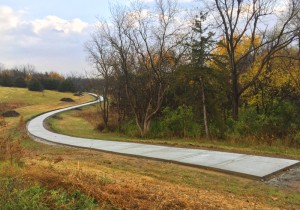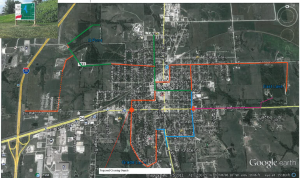The City of Osceola, along with Clarke County, continues to build on the “Let’s Move Osceola” program and improve on the beauty and draw of our community through the construction of an intricate trail system. These trails will ultimately connect area parks to the “Safe Routes to School” program as well as the Osceola Square and, eventually, expand to connect with other health-conscious communities.
Community health-focused trail systems are adding tremendous value and regional appeal to many rural areas throughout Iowa, and Osceola is one community leading the way. The “Let’s Move Osceola” program, based on a 2005 study, was the genesis of a concept to create a trail system throughout Osceola. Focused on inspiring healthy activities throughout the community, the trails system was estimated to be in excess of $3 million to develop. Through careful consideration and budget reviews, the program was shelved to focus on immediate needs like the “Safe Routes to School” program for local students.
When the “Safe Routes to School” program was kick-started by a $75,000.00 grant from Wellmark, Clarke County Development Corporation and the City of Osceola devised a strategy of also launching the “Let’s Move Osceola” trail system, but one piece at a time, complementing and augmenting the Safe Routes map as well as removing the burden of funding for the entire project.
“When we saw the interest Wellmark and other sponsors of the Safe Routes program were showing, we knew we had a great plan,” Bill Trickey of the Clarke County Development Corporation stated. “By breaking up the overall project, the ‘Let’s Move Osceola’ program fit seamlessly with the bigger picture of inspiring our entire community to pursue a healthier active lifestyle.”
The final proposed map for the two programs has access to pathways that wind through and around Osceola and the surrounding areas.
By partnering with Joe Johnston, owner of Johnston Properties, Bill Black, one the members of the Osceola Board of Supervisors, and Knapp Krause LC, Clarke County Development and the City of Osceola procured the land needed for the first part of the extended trail in the South West corner of Q-Pond Park.
While the first designs had the trail created with gravel, it was determined to be in the best interest of the community to make the trail concrete. Ty Wheeler, Osceola’s City Administrator began the task of gathering bids and finding the capital to make the “Let’s Move Osceola” trail system a reality.
Through the combined backing efforts of the Clarke County Development Corporation Board, the City of Osceola, and Osceola Chamber Mainstreet, the start of a beautiful trail is now available, winding its way along Clay Street out to Q-Pond Park, where it can then be taken along the West side of the park out to Q Pond Park Dam.
Soon Osceola residents and travelers from surrounding communities will be able to walk, run or bike from East Lake Park, to Q-Pond, through the city square and out to Grade Lake, creating a health-focused destination in Osceola and Clarke County.
Future improvements funded by an already-approved grant from the Iowa Health Department as well as donations from the Rotary Club and other beneficiaries, include exercise stations along the trail to help improve the health and wellness of the community and all who will come enjoy the new trails.
By integrating with the Safe Routes to School system, students also will be able to safely take walking field trips down Kossuth Street to Highway 34 where they can travel out to East Lake Park to study nature, observe the swans at the lake, get some fresh air and exercise.



I am pleased about the new walking trails in town. However, I think the community could do better by opening school gyms to those who do not want to be on a volleyball or basketball team. Yes. People can walk on the perimeter while those games are going on. Check with the folks who operate Chariton’s community center. It is open to All, All the time.
Hi, Pat –
Thanks for your comment, but Clarke school facilities are managed and maintained to provide the best service, security, and well-being of our students and staff. To have the facilities open to the public would require additional security, insurance, maintenance, and management. While we understand other communities offer this service, we can not justify the costs of maintaining such a program.
S.Seid